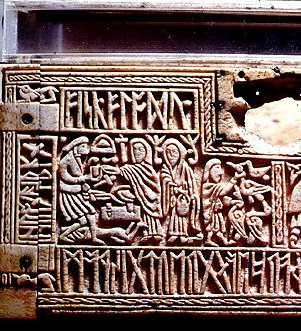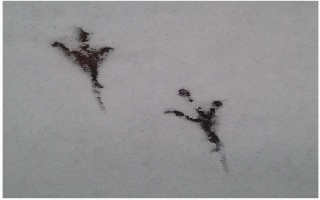|
||||||
|
2. Front left: Welund-Picture
The picture is structured in three scenes: The first one shows the smith at his anvil, the decapitated body of a child, Niðud’s son, at his feet, the head in a pair of tongs. He will turn the skull into a chalice (quite fashionable with enemy heads those days). When the unsuspecting father drinks from that ghoulish vessel, he will extinguish his own 'lifeline', just as he used to do it with his enemies. However, he and his family could live on in his daughter, whom we see here standing next to the anvil. Beaduhild (her name, both components, beadu and hild, spells ‘war’) reaches for a cup filled with drugged beer. The smith will seduce her and make her pregnant. As Niðud had to promise not to harm his daughter Welund will live on in his son at his enemy's court. The second scene, separated by 'ornamental' signs, shows a woman carrying a bottle. She, most likely, was the one who brought the drugged drink (brewing was the landlady's duty and poison was the favourite female weapon). If so, she was the companion of the elfish smith, Alwit by name (the Edda refers to her as 'swan maiden' or 'Valkyrie', who is helping her partner to complete his revenge. Thus she adopts the part of a fylgja, the ‘following woman’, who helps her protégé through the troubles of life.
Now he is able to change his nature and to escape in the shape of a bird (as shown on the Gothland standing stone
This way there is a double function to this image. For one thing, it depicts Welund as a source of wealth, for the other it is emblematic for the protective function of a wise (valkyrian) partner. It may augment partnership, be it with a helpful wife, be it with the warrior's fylgja.
As there is no detail without meaning, we will have a closer look at some details, seemingly merely ornamental. If we interpret them as disguised runes, we are risking, may be, some rather speculative conclusions.2 All the same, there are some dots, one above Welund's head, two more above the throne of virgin and child. If one dot (value 1) stands for the first rune,
It might be too far fetched if we counted the elements in the arch and the steps that constitute the throne. If we did we would arrive at 21
Again we note that the two pictures and the two alliterating runes in the 'Verses on the Whale' do correspond, as both refer to
1 W. Golther, Handbuch der germanischen Mythologie (1895)s. 128 f.: "Aber Wölund heißt alfa ljóþi, alfa visi, d.h. der Elben Fürst und Beherrscher. Die Schmiedekunst wird ursprünglich den Elben überhaupt zugehört haben und erst allmälig den Zwergen insbesondere überwiesen worden sein. ... Die Elben können jede Gestalt annehmen. Unter Menschen erscheinen sie meistens in menschlicher Grösse. ... Die Elben sind edel und hilfreich, aber auch äußerst boshaft ..." 2The first one to interpret these ‚ornaments' as runes was Karl Schneider in: Die germanischen Runennamen (Meisenheim 1956) 3 King Alfred (*849 †899), in his translation of Boethius' († ~ 525) "Consolation of Philosophy", substituted the name of Weland, for that of the Roman Fabricius (Latin 'faber' for 'worker', in particular for 'smith'), so that it would be recognized more readily by the reader. He added the apposition "the famous and wise goldsmith," which indicates on the one hand that Welund was synonymous with the skilful goldsmith, and on the other hand it shows that the great Christian King did not hold the deeds (murder and rape, as we understand them) against Welund, as he may have understood them as necessary for the liberation of Niðud's captive. |
||||||
|
||||||
|

 The
The  However, even more clearly read the signs right and left of the Valkyrie's head. They are floral variant of the rune
However, even more clearly read the signs right and left of the Valkyrie's head. They are floral variant of the rune 


